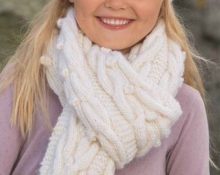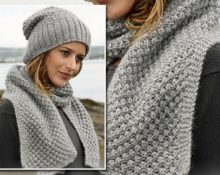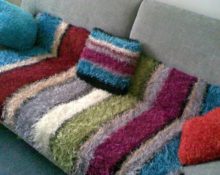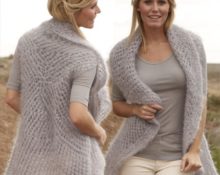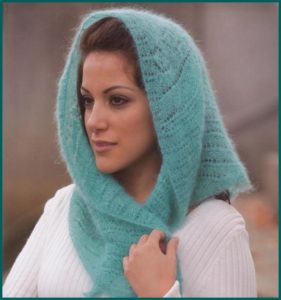 The headscarf is one of the very first women's headdresses.
The headscarf is one of the very first women's headdresses.
In the past in Rus', not a single representative of the fairer sex could do without this unusual thing. But even today this headdress remains the same relevant and beloved item. It is appropriate on the head of a little girl and will perfectly complement the outfit of a business woman.
This is especially true for hand-made knitted items. Let's take a closer look at what beauty and how you can create using knitting needles.
What you need to knit a scarf
Proper preparation of the knitting process is the key to its smooth progress and achievement of an ideal result. Preparation consists of choosing the model you like, suitable yarn and knitting needles. Unlike other knitted wardrobe items, you don't need to create a pattern. Because a knitted scarf always has a triangular shape and differs only in size.The product can be dense or have an openwork appearance.
Yarn
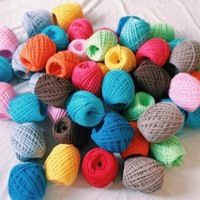
The material for the product must be chosen correctly. To do this, you need to decide on the following characteristics.
- Seasonality. Summer models are made from linen, cotton, silk or viscose fiber. For the cold season, it is better to use wool, alpaca, angora or mohair.
- Owner's age. For little ones, bright, playful colors of the future item are preferable. And for women it is better to use a monochromatic range of pastel colors.
- Density headdress. If you want to create a lace version, then take thin threads.
Reference! If you knit this item from acrylic, you can wear it all year round.
Spokes
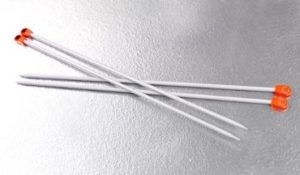
Tool selection is another important step in the preliminary process. Knitting needles are selected according to the thickness of the thread used. The larger the fiber, the larger the tool you will need.
To make the right choice, fold the thread in half and compare it with the thickness of the knitting needle. It must be identical. You can also use the manufacturer's recommendations indicated on the yarn label.
The uniqueness of knitting a women's headscarf
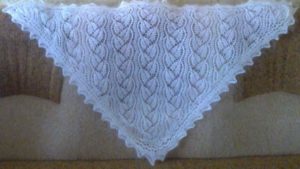
The whole difficulty of knitting this headdress lies in achieving the shape of an isosceles triangle. This can be achieved in several ways.
- First way. The fabric is knitted from the widest edge with even decreases in stitches along the edges.
- In the second option to begin with, cast on 13 stitches on the knitting needles. Then mark the seventh and in every second row, one new loop is knitted from adjacent to the marked loops. At the same time, two loops are knitted together at the end of the row. Make the canvas of the required size. Then only additions are performed. This method is especially good when knitting openwork symmetrical patterns..
- Third option. Differs in the opposite direction of knitting. Cast on three loops on the knitting needles and, to expand, knit three loops from the central one.
All these methods are good because the product can be tried on during the manufacturing process. Therefore, it is easy to calculate the length of the canvas.
Important! After washing, the finished product must be secured in its unfolded form with pins until it dries completely.
This process is called blocking.
Knitting scarf models
There are a huge number of wonderful models of this thing. Some are simple, but there are real puzzles that require considerable skill, imagination and patience to implement. But any of these creations can transform and decorate a woman’s appearance. And also to make her stand out from the crowd or attract the attention and charm of representatives of the opposite sex. You can also give such an item as a gift to a loved one, sharing with him the warmth of your heart. It’s not without reason that they say that a master puts a piece of his soul into his creation.
We offer descriptions that will help you knit a fashionable scarf.
A simple model for beginners
For needlewomen who decided to knit this item for the first time, you should not choose a complex model. It is enough to choose an unusual yarn. An item made from sectional colored fiber looks quite impressive. We offer a model that is quite simple and quick to make.
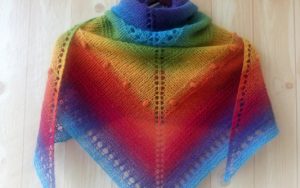
To implement this you will need the following.
- Sectional colored wool yarn with parameters 400 m\100 g.
- Knitting needles 2.5.
Completing of the work
- Cast on 13 stitches and knit a row.
- From the next row, knit in stockinette stitch.In every second row, perform yarn overs on the sides of the central loop, and decrease at the end of the row.
- After you reach the desired width of the fabric, perform only yarn overs.
- To form a pattern at the desired height, purl two rows and make a “bump” pattern between them according to the pattern.
"Bump" pattern
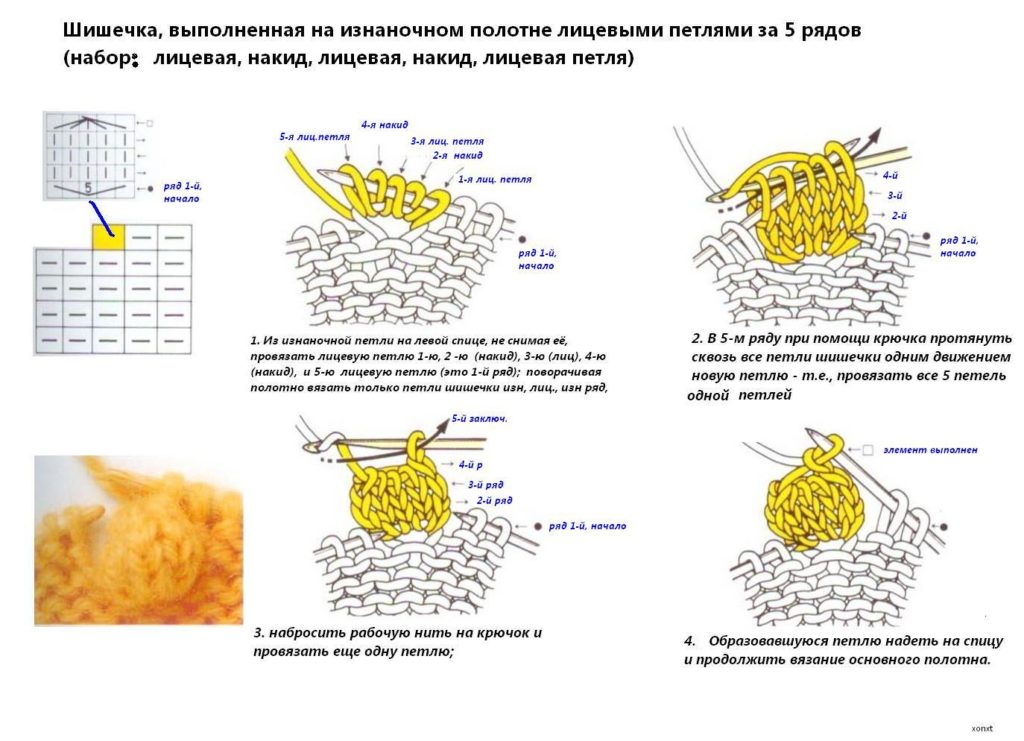
- Work six rows of garter stitch at the beginning and end of the fabric at equal distances from the central pattern.
- For an openwork border, eight rows before finishing work, knit a row with a hem pattern: 2 sts together, knit stitch, yarn over.
If you wish, you can decorate with a hook border. Carry out wet-heat treatment and block the gusset.
Tight headscarf
For the cold season, it is better to use models knitted with dense patterns made of bulky yarn or wool. This option will not allow the cold air to pass through and will perfectly protect you from the dampness of late autumn. Moreover, by combining simple patterns, you can create a unique variation of the headdress.
Model "Rice and gum"
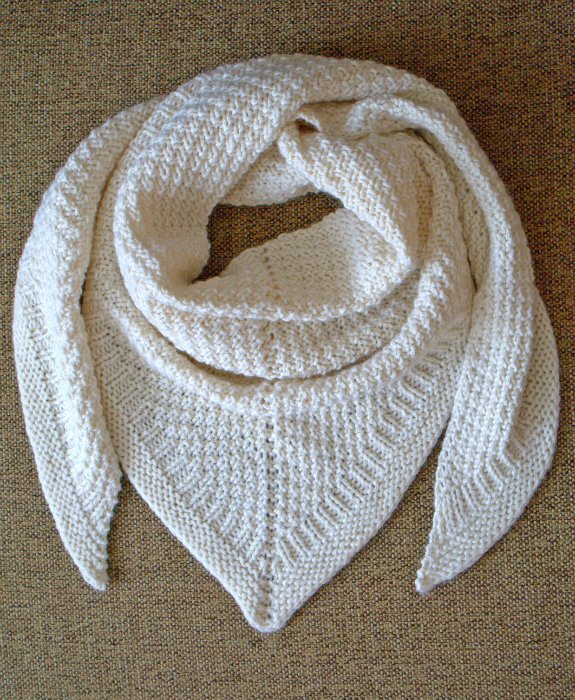
Required materials: wool yarn with parameters 300 g\100 m and knitting needles No. 3.
Description of work
- The canvas is done from top to bottom.
- Having started work, we knit with the “Rice” pattern in accordance with the description (1 r.: 1 l.p. and 1 i.p.; 3 r.: 1 i.p., 1 l.p.; 2–4: loops knit according to the pattern; repeat rows 1–4).
- At the same time, in the center, knit three loops from the central loop in every second row and include them in the pattern. To give shape along the edges, along with increases, decrease an equal number of loops on both sides.
- Having reached the desired width, perform only central increases.
- To form a border, perform six rows with a 1x1 elastic band.
- Finish the fabric with 10 rows of garter stitch.
- Carry out WTO scarves.
Advice. Using the example of the pattern of this product, you can knit other variations, replacing the patterns with the designs you like.
Openwork scarf
Not only dense variations can protect you from winter weather; a lace model made of mohair can easily cope with this task. Such a thing, in addition to warmth, has another wonderful quality: an airy charm that gives the scarf a feeling of tenderness. It seems that it softly and weightlessly envelops your shoulders. And knitted from summer yarn, fine linen or silk, it will warm and decorate you on a summer evening.
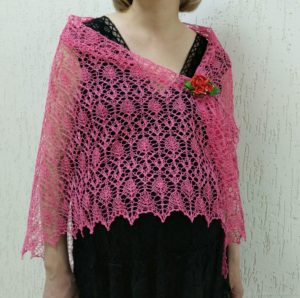
This item can be made in summer and winter versions. In the first case, for openwork knitting you will need linen or silk yarn, in the second - angora or mohair.
Execution Process
- Knit a triangular fragment with facial loops: cast on 3 p. and tie 6 p. Then throw on 3 edge loops from the nearest and 2 stitches of the cast-on edge.
- Continue knitting in accordance with the patterns. We start with diagram A.
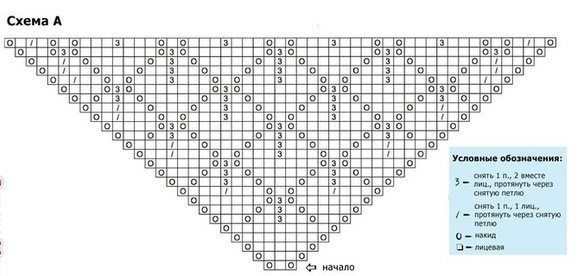
- Then continue working according to scheme B.
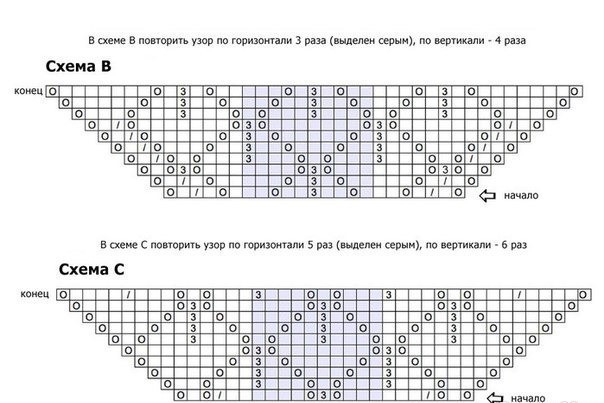
- Then knit according to pattern C.
- Work eight rows in garter stitch.
- Close the edge with a picot pattern: add 2 sts with an additional set, bind off 6 sts, repeat these steps until the loops run out.
- Wash and secure the scarf with pins on a flat surface.
New models: bactus scarf
Fashion does not stand still, and from time to time it gives us interesting knitted items. One of them is a hybrid of a headscarf and a scarf, popular among women. We are talking, of course, about bactus. This original item harmonizes well with clothing of different styles.. It is also much more practical than a simple scarf, since its surface area better covers the chest and neck area. At the same time, it does not cause discomfort when used.
As an example and sample, we propose to consider a rather elegant variation.
Bactus with leaves
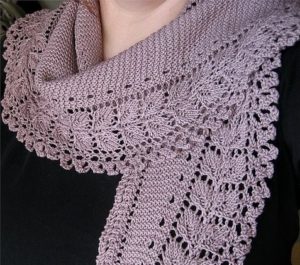
To make bactus you will need yarn of medium thickness (300 m\100 g) and knitting needles No. 4.
The product is made according to scheme 1 with a gradual expansion and then narrowing of the canvas.
Scheme 1

Increases are made after the blue line. Loops are decreased in the same way as additions. After finishing knitting, perform wet-heat treatment of the product.
Useful tips for knitting a scarf with knitting needles
And finally, I would like to give some useful recommendations that will help you facilitate the work process and achieve a good final result.
- Before use, wipe the metal tool with a soft cloth. Especially if it is new or just purchased, because an invisible plaque will form on it over time. Not only does it prevent the threads from sliding along the knitting needle, but it can also stain the yarn.
- Rewind the fiber into a ball before use. Sometimes unpleasant surprises can await you inside the skein in the form of thread breaks or manufacturing defects. This will also prevent the yarn from getting tangled during the knitting process.
- Always place the skein in an empty container. This will keep the threads from getting dirty and will protect the yarn from getting clogged with hair or pet hair.
- If you are knitting according to a complex pattern, then make a photocopy and cross out the knitted row. This method will help you avoid getting confused and confused.
- Do not neglect blocking the product, especially if it is a lace model. With this action, the scarf will acquire a strict shape, clear design and external lightness.
I hope you are convinced that it is not so difficult to please yourself or your loved ones with a stylish and attractive update. A knitted scarf will require only desire and a few free evenings.Imagine, create and give your loved ones the warmth of your soul. Even loops for you!


 0
0